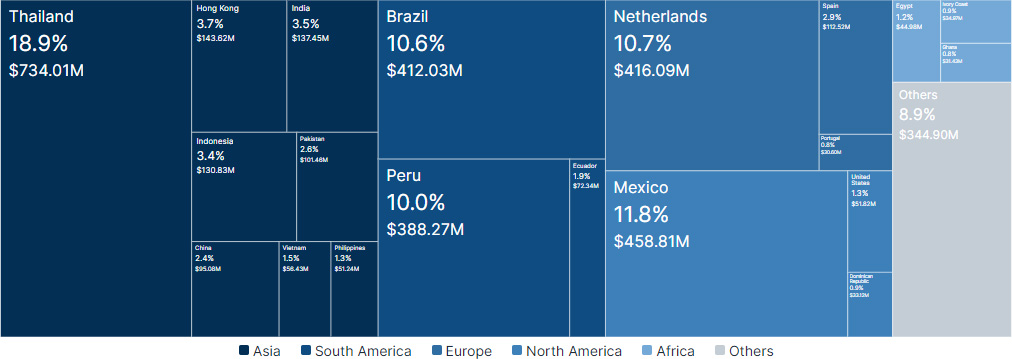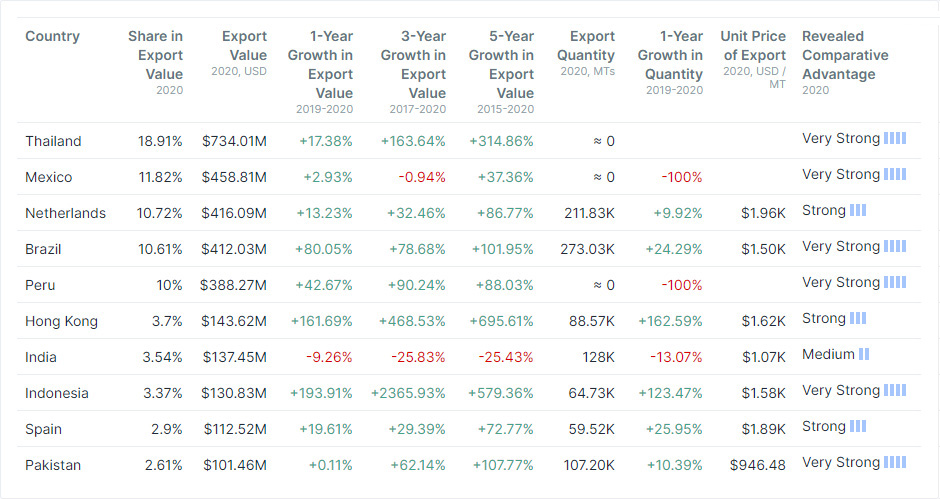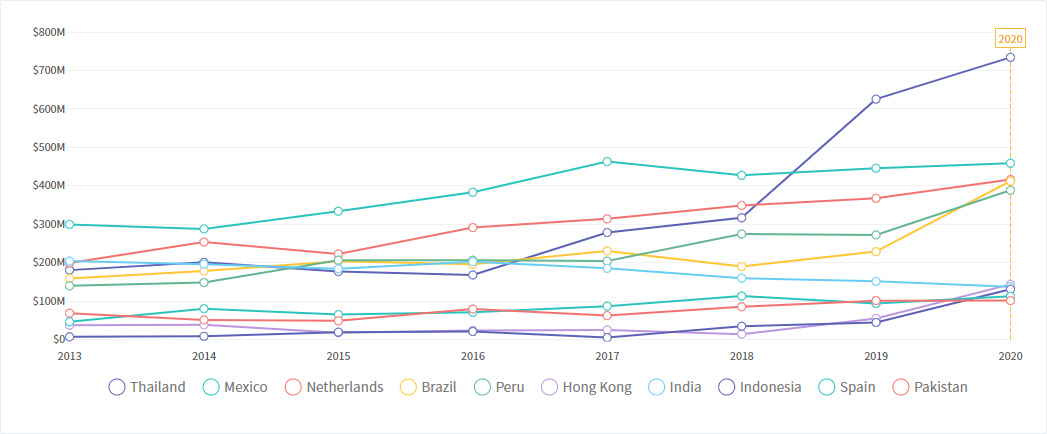Global Mango Production, Consumption, and Exports
The globalization of mango production and consumption is a relatively new phenomenon that is experiencing rapid growth. Over the past ten years, trade-in mango products alone have tripled to over USD 2 billion, with supply unable to keep up with demand. Mangos are native to South East Asia and have become one of the most widely cultivated fruits in the tropics. It is the national fruit of India and Pakistan with the earliest known reference to the cultivation of mangos being traced to India up to 2,000 BC There are more than one thousand varieties, and each country produces a different set of mangos with their own specific characteristics.
Mango trees grow in frost-free, warm tropical and subtropical climates, primarily in Asia, Latin America, and Africa. The leading mango-producing countries are India and China with approximately 46% and 8% of total global production, respectively. Although mango is the fifth most cultivated fruit in the world, most of the production is still locally consumed with trade relatively limited due to lack of export supply. To put things into perspective, India is the world’s largest producer and yet exports less than 1% of its production.
Plantations International’s Mango Plantations in Thailand have Received a USD 112,213,867 Revenue Valuation.
The global mango market is still evolving with demand rising as people become more familiar with it and include it into their diets. Health-conscious consumers are including them more and more into their diets as mangos are low in calories, high in fiber, and a great source of Vitamin A and Vitamin C. In the U.S mango as an ingredient in the foodservice, the segment has increased in penetration from 1.9% in 2008 to 15.4% in 2013. Mangos are found in juices, ice cream, cereals, and pastries among many other food products. There is particularly high demand for ready-to-eat mangos in individual containers, as well as processed mangos, including dried and pureed mango.
Top Mango Exporting Countries by Market share 2020
Thailand Dominates the World’s Mango Export Market with an 18.9% Market Share
Over the past 10 years trade in mango products alone has more than tripled, rising an average 12% p.a.
Mango World Trade
- Mango global production reached a record high of 45 million MT in 2018.
- Almost all mango production is consumed domestically with world trade accounting for only 4% of total production.
- India is the world’s largest producer of mangos accounting for 46% of global production followed by China and Thailand with 8% and 7% respectively.
- Although Asia produces over 75% of all mango supply annually, its share of the export market is severely disproportional. Regionally, South America dominates exports with over 50% followed by Asia with 36%.
- South American countries are export-orientated led by Mexico, Peru, and Brazil who together account for 50% of all exports.
- The U.S is the world’s largest importer of mangos, importing 476,908 MT last year. 66% of which come from Mexico followed by Ecuador and Peru.
- EU countries collectively import over 450,000 MT of mangos. One-third of this is related to re-export from other EU countries, mainly the Netherlands. More than 40% of EU imports come from South America and about 10% percent from Asia.
- The Netherlands is a global transit country. 35% of its imports go to Germany and it is the source of 40% of all of the French mango imports.
- The U.K import market is very different to the rest of Europe. The majority of mangos imported come from Pakistan and India while the rest of Europe is highly dependent on South American varieties.
Export Trends of Top 10 Exporters of Mango from 2013 to 2020
Mango Growing Facts
- The mango is one of the most cultivated fruits in tropical areas of the world, it is native to the South Asian areas of Eastern India, Burma and the Andaman Islands.
- Buddhist monks are believed to have introduced the mango to Malaysia and eastern Asia around the 5th century B.C. Legend has it that the God Buddha found tranquility and meditated under the cool shade of a mango tree.
- The evergreen mango tree can grow as high as 35 – 40 m (115–130 ft.). They are a long-living tree with some specimens having been known to still bear fruit after 300 years.
- The flowers of a mango tree are small and white with five petals, and the fruit takes between three and six months to ripen.
- Mango fruit can come in various shapes, size,s and colors including yellow, orange, red, and green.
- Mangos contain many nutrients. The vitamin content depends on the variety and maturity of the fruit. When mango is green and still growing there is a high vitamin C content, as the fruit ripens and matures the amount of beta carotene (vitamin A) increases.
- Nearly half of the world’s mangoes are produced in India, but the country accounts for less than one percent of the international mango trade due to the fact India consumes most of its own production.
- More fresh mangoes are eaten around the world every day than any other fruit.
- Mangoes are a very common food used in a number of cuisines around the world, especially in the tropics. The fruit is used in all types of meals and courses such as breakfast, lunch, dinner, dessert and used in refreshing juices.
- Sour, unripe mangoes can be used in chutneys, pickles, as side dishes, or eaten raw on a stick dipped in salt, black pepper, chili, lime, or soy sauce.
- Mango lassi is a very popular drink throughout South Asia, it is a combination of ripe mangoes or mango pulp with buttermilk and sugar. Aamras is also a popular thick juice made of mangoes with sugar or milk, and is often consumed with bread or rice. Mangoes are added to smoothies and as a topping on ice cream.
- Mango salsa and chutney are very popular as accompaniments to salads, chicken, and fish or served as a snack.
- Ripe mangoes are often used as an ingredient in curries.
- The mango is the national fruit of India, Pakistan, and the Philippines. It is also the national tree of Bangladesh.
- In India and several other cultures, the mango fruit and leaves are ritually used as floral decorations at weddings, public celebrations and religious ceremonies.
- Giving someone a basket of mangoes is considered a gesture of friendship.
- Common mango varieties in countries such as the US and UK include Tommy Atkins, Haden, Kent, Keitt, Ataulfo, and Francis. In Asian countries such as India, popular varieties include Alphonso, Benishaan, Kesar and Chaunsa.
Introduction to Mango Farming
The mango is a juicy stone fruit and belong to the family of “Anacardiaceae” and genus of “Mangifera”. Mangoes have been grown in South Asia for thousands of years & reached East Asia between the 5th and 4th centuries. Mango is one of the top fruit crops of India and other Asian countries. Mango fruit is called the king of fruits. Mangos are delicious, excellent flavour and attractive fragrance, these fruits are good source of vitamin ‘A’ and Vitamin ‘C’. Mango trees are hardy in nature, can be grown in a wide-range of soils and require comparatively low maintenance. These fruits can be utilized at all stages of its development. Raw mangoes are used for making chutney (pickle) and juices. The ripe mangos can be used in preparing desert, squashes, syrups, nectars, jellies and jams. This fruit kernel also contains 8 to 10 % good quality fat which can be used for soap and also as a substitute for cocoa butter in confectioneries. Commercial cultivation of mango crop is very much successful in southEast Asia. Mango trees can be grown in pots, back yards, greenhouses and poly houses as well.
Climate Requirements
Mangos can be cultivated in both tropical and sub-tropical regions from sea level to 1500 meter altitude, provided there is no high humidity, rain or frost during the flowering stage. Having good rainfall and dry summer is the best suitable conditions to grow mangos. Avoid areas with high winds and cyclones which may cause flowers and fruits shedding and breaking of branches.
Soil Requirements
Mango fruits can be cultivated on wide variety of soils from alluvial to laterite. The soil should be well-drained and deep (minimum of 6′). Mango trees prefer slightly acidic soils with pH 5.5 to 8.0.
Mango Propagation
The vegetative method ( true to type plants from recognized nurseries) of propagation is the most recommended one. Mango can be propagated by seeds, Inarching, veneer grafting, side grafting and epicotyl grafting.
Land Preparation, Planting and Spacing
Plough the land couple of times until the fine-tilth stages is achieved followed by harrowing and leveling. Prepare the soil in such a way that the excessive water will drain-out quickly. Generally Spacing between plants varies from variety to variety. In less growth areas (dry zones), a spacing of 10 meter x 10 meter is preferred whereas in regions with heavy rainfall and rich soils where abundant vegetative growth occurs, a spacing of 12 meter x 12 meter is recommended. Dwarf hybrid mango varieties can be spaced at 5 meter x 5 meter. Pits should be filled with original soil mixed with 25 kg well rotten farmyard manure, 2.0 to 2.5 kg single super phosphate and 1 kg muriate of potash. One year old healthy, straight growing grafts from reliable nurseries should be planted at the centre of pits dug along with the ball of the earth intact during the rainy season so that the roots will not be expanded and the graft union will be above the ground level. Mango plants should be irrigated immediately after planting in the field. In the initial 1 or 2 years, it is recommended to provide some shade to the young mango plants and also stake to make them grow straight direction.
Manures and Fertilizers
Usually, 160 gm to 175 grams of urea, 115 grams of single super phosphate and 115 grams of muriate of potash/plant/year should be applied from age from 1 st to 10th year and thereafter 1.6 kg, 1.1 kg, and 1.15 kg respectively of these fertilizers per plant per year should be applied in 2 equal split doses (June to July and October). In sandy areas, foliar spray of 3% urea is recommended before flowering.
Irrigation
Irrigation should be given immediately after transplanting the mango plants in the main field. Young mango plants/seedlings should be irrigated frequently for proper establishment in the soil. Irrigation can be carried out at an interval of 8 to 12 days from fruit set to maturity to result in higher crop yield. Irrigation is not recommended for 2 to 3 months prior to flowering as it is likely to promote vegetative growth and impacts the yield. Drip irrigation is preferred in mango cultivation.
Intercropping
Farmers can utilize the interspaces between mango rows and make extra income. Inter-crops like any vegetables, legumes, papaya, guava, plum, and peach can be cultivated depending on the agro-climatic conditions of the area. It is important to note that the water and nutrient requirements of inter crops are separate from mango tree requirements.
Intercultural Operations
As part of pruning and training activity, about 1 meter from the base on the main trunk of the mango plant should be kept free from branching. The main stem can be allowed thereafter spaced at 20 to 25 cm apart to allow growth in different directions. Branches that cross over/rub each other should be removed at pencil thickness. Dried and diseased branches should be removed from the mango trees. Weeds can be controlled by weedicides and mulching.
Pests and Diseases
The following are the most common pests and diseases and their control measures.
- Mango Hopper: 2 sprays (at panicles emergency and at pea size of fruits) of carbaryl (0.15%), monocrotophos (0.04%) or phosphamidan (0.05).
- Mealy-Bug: Ploughing inter spaces in November and dusting 2% methyl parathion @ 200 gram per tree near the trunk and fixing 20 cm wide 400 gauge polythene strips around the trunk with grease applied on the lower edge in January as prophylactic measures and 2 sprays of monocrotophos (0.04%) at 2 weeks interval as control are needed.
- Powdery Mildew: 2 to 3 sprays of wettable sulphur (0.2%) or Karathane (0.1%) at 12 to 15 days intervals.
- Anthracnose: 2 sprays of Bavistin (0.1%) at fortnight interval.
- Malformation: 1 spray of 200 ppm NAA in October followed by de-blossoming at bud burst stage in December – January.
- Fruit Drop: Regular irrigation during fruit development, timely and effective control of pests and diseases, and spraying 20 ppm NAA at pea size of fruits can prevent the fruit drop.
Harvesting and Yields
Generally, graft plants start bearing mango fruits at the age of 3 to 4 years (10-20 fruits) to give optimum crop from 10 to 25th year which continues to increase up to the age of 40 years under good mango farm management.
Post-Harvesting Activities
Shelf life of mangoes is short (2 to 3 weeks), hence they should be cooled as soon as possible to a storage temperature of 12°C. Steps involved in post-harvest handling are preparation, grading, washing, drying, waxing, packing, pre-cooling, palletization, and marketing. Mangoes should be packed in corrugated fiberboard boxes sizes of 40 cm x 30 cm x 20 cm. Mangos should be packed in single layer 8 to 15 fruits per carton. The boxes should have more than sufficient number of air holes which is an about 8% of the surface area to allow good ventilation and prevent from damage.
Marketing Your Mango Farm
Usually, many fruit agents will come to your farm to buy in bulk. The fruits also can be transported to local markets. Even some farmers give the total farm on lease base for each crop.
The Bottom Line in Mango Farming
Farmers can get pretty decent profits in mango farming, provided they follow good farm management practices. There are some schemes and loans available for mango farming. For complete details, contact the nearest bank or any financial institutions or agriculture department.
To find out more about how Plantations International can help you develop and manage your own mango plantation and to receive a free initial consultation, please call us today on +852 5808 3775 or Click Here to contact your nearest Plantations International representative.



